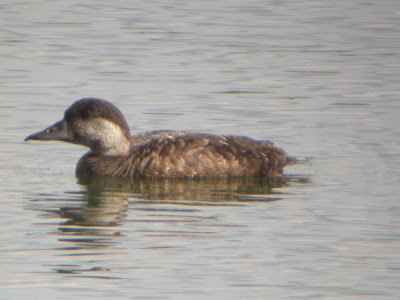The juvenile Med Gull is still being seen most days. It has started moulting its scaps now - I first noted this last Monday (5th) and took this record showing a nice pale grey scapular:
Today there was nothing unusual of note, but it was interesting to see at least 5 broods of Great Crested Grebes with recently hatched young - I saw broods of 4, 2, 2, 1 and 1+ (at least 1 hidden on the adult's back). They have hatched quite late, but obviously find the lake to their liking. A single winter plumaged Dabchick was also lurking under the island.
I have managed a couple of off patch visits recently. Firstly to see a nice adult Pec Sand at nearby Eton Wick, Berkshire on Sunday 4th. There was a juvenile at this exact same location last Autumn, so you could speculate that it is the same bird using the same route. The bird was keeping the company of 2 adult Dunlin, but refused to fly into Bucks as last year's bird did on several occasions.
Secondly, a visit to Tring Reservoirs, specifically Startops End Reservoir in mid Bucks. A 1st summer female Common Scoter had been showing well for several days, so I decided to take a look. This reservoir is a bit frustrating for county birders as the Herts/Bucks boundary runs through the NW part of it, most of it being in Herts, but the smaller NW side being in Bucks. If the bird is flying, such as last year's Sabine's Gull, then it can easily enter both counties, but a more sedentary bird such as last year's Snow Bunting can be more difficult. Luckily for me, the Common Scoter was in the NW corner on my arrival as that is where the loafing wildfowl flock was frequenting, so no waiting for it to swim into the 'correct' county.
And finally a couple of interesting non-avian garden records. I am lucky that I get Silver-washed Fritillary butterflies annually in the garden as a small breeding population frequents the adjacent woodland. Over the past week, a couple of females had been visiting the buddleia bushes and also ovipositing all over the place, including in the brickwork of the house under the damp course.












